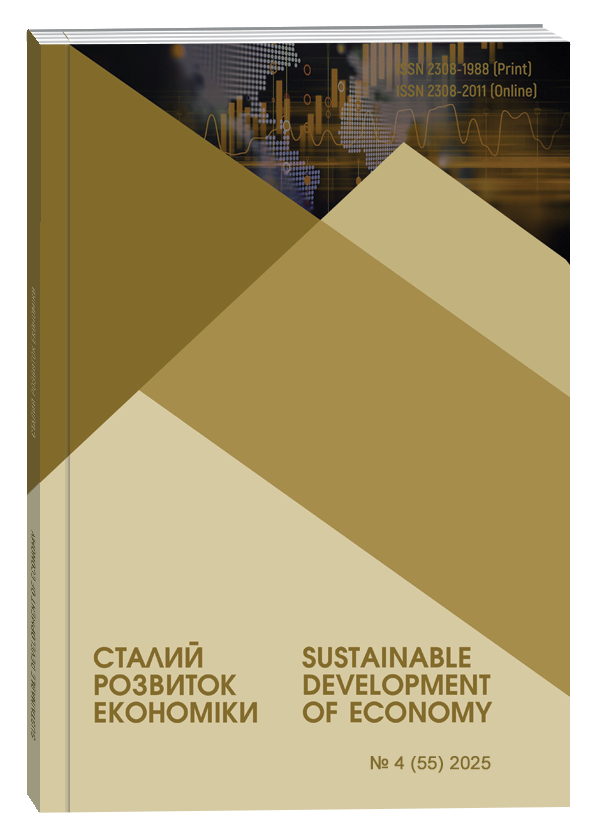EVOLUTION OF FOREIGN DIRECT INVESTMENT THEORIES: FROM CLASSIC CONCEPTS TO MODERN ADAPTATIONS
Abstract
This article comprehensively examines the evolution of theoretical approaches to analyzing Foreign Direct Investment (FDI), tracing their development from classical foundations to modern adaptations within the context of the digital-green transformation. It provides a critical analysis of the key theories that have shaped the understanding of international investment activity, including K. Akamatsu’s "flying geese" paradigm, R. Vernon’s product life cycle theory, S. Hymer’s theory of oligopolistic advantage, C. Kindelberger’s imperfect markets theory, P. Buckley and M. Casson’s internalization theory, M. Porter’s diamond of national competitive advantage, and J. Dunning’s eclectic paradigm (OLI). The study argues that while these classical theories retain historical significance, they exhibit considerable limitations in explaining the contemporary realities of the European Union (EU), where digitalization, the green transition, and deep market integration are redefining investment priorities. The paper substantiates the necessity of adapting traditional models to these new imperatives, culminating in the proposition of an original Digital-Green OLI (DG-OLI) model. This framework reconceptualizes the traditional ownership (O), location (L), and internalization (I) advantages to align with the EU's digital and green agendas, emphasizing digital-green firm competencies, institutional-innovative country attractiveness, and the strategic internalization of key technologies to ensure technological sovereignty. Significant attention is devoted to Dunning and Narula’s "investment development path" (IDP) theory, which effectively elucidates the evolution of EU member states from capital importers to active capital exporters. Employing a systematic and comparative analysis, the research finds that contemporary investment activities within the EU are increasingly determined by institutional incentives, a favorable regulatory environment, and innovation capacity, rather than by traditional economic factors alone. The conclusion posits that a synthesis of the eclectic OLI paradigm, enhanced by the DG-OLI model, and the IDP theory provides a robust foundation for analyzing the role of EU member states in global investment flows and for crafting effective investment policies in an era of global uncertainty and transformative change.
References
Khodijah A. S. The Influence of Environmental, Social, and Governance Performance on Foreign Investment. Journal of Accounting and Investment. 2023. Vol. 24, No. 1. P. 64-83. DOI: https://doi.org/10.18196/jai.v24i1.16033
Akamatsu K. A Theory of Unbalanced Growth in the World Economy. Weltwirtschaftliches Archiv. 1961. No. 86. P. 196-217. URL: https://www.econbiz.de/Record/a-theory-of-unbalanced-growth-in-the-world-economy-akamatsu-kaname/10001819196 (дата звернення: 21.09.2025).
Kojima K. Direct Foreign Investment: A Japanese Model of Multinational Business Operations. London : Routledge, 2010. 246 p. DOI: 10.4324/9780203845660
Kojima K. Macroeconomic Approach to Foreign Direct Investment. Hitotsubashi Journal of Economics. 1973. Vol. 14, June. P. 1-21. DOI: 10.15057/8008
Vernon R. International investment and international trade in the product cycle. Quarterly Journal of Economics. 1966. Vol. 80, No. 2. P. 190-207. DOI: https://doi.org/10.2307/1880689
Hymer S. A Study of Direct Foreign Investment. Cambridge (Mass.): MIT Press, 1976. 253 p. URL: http://www.sciencedirect.com/science/article/pii/0304-3878(77)90016-5 (дата звернення: 21.09.2025).
Kindleberger C. P. The Theory of Direct Investment. In: American Business Abroad. New Haven : Yale University Press, 1969. P. 1-266. URL: https://www.scirp.org/reference/referencespapers?referenceid=1920235 (дата звернення: 21.09.2025).
Porter M. E. The Competitive Advantage: Creating and Sustaining Superior Performance. New York: Free Press, 1985. 557 p. URL: https://www.hbs.edu/faculty/Pages/item.aspx?num=193 (дата звернення: 21.09.2025).
Buckley P., Casson M. The optimum timing of foreign investment. Economic Journal. 1981. No. 91. P. 75-87. DOI: https://doi.org/10.2307/2231697
Dunning J. H. Determinants of International Production. Oxford Economic Papers. 1973. No. 25. P. 289-336. URL: https://www.jstor.org/stable/2662317 (дата звернення: 21.09.2025).
World Investment Report 2006. FDI from Developing and Transition Economies: Implications for Development. UNCTAD. 2006. URL: https://unctad.org/publication/world-investment-report-2006 (дата звернення: 21.09.2025).
Carmen S., Fon R. Revisiting Dunning's Investment Development Path: The Role of Home Country Institutions in Outward Foreign Direct Investment by Emerging Economies Multinationals. 2023. DOI: http://dx.doi.org/10.2139/ssrn.4600116
Hykmete B., Nazmi Z. Theories of Foreign Direct Investment (FDI) and the Significance of Human Capital. International Journal of Business and Management. 2019. Vol. VII, No. 1. P. 11-24. URL: https://ideas.repec.org/a/sek/jijobm/v7y2019i1p11-24.html (дата звернення: 21.09.2025).
Dunning J. H., Narula R. The Investment Development Path Revisited. In: Theories and Paradigms of International Business Activity. 2002. P. 138–172. URL: https://www.researchgate.net/profile/Rajneesh-Narula/publication/286269707_The_investment_development_path_revisited_Some_emerging_issues/links/5673dc0108ae04d9b09be4c7/The-investment-development-path-revisited-Some-emerging-issues.pdf (дата звернення: 21.09.2025).
Kuzel M. The investment development path: Evidence from Poland and other countries of the Visegrad group. Journal of East-West Business. 2017. Vol. 23, No. 1. P. 1-40. DOI: https://doi.org/10.1080/10669868.2016.1180659
Satoglu E. B. Emerging through foreign investment: investment development path estimation of MINT economies. Advances in Economics & Business. 2017. Vol. 5, No. 5. P. 256-264. DOI: https://doi.org/10.13189/aeb.2017.050503
Dai K. Investment development path: the applicability of measurement criteria and further development. E3S Web of Conferences. 2021. Vol. 275. P. 10-23. DOI: https://doi.org/10.1051/e3sconf/202127501023
Trapczynski P., Gorynia M., Nowak J. et al. How Does Economic Integration Affect Progress along the Investment Development Path? A Case Study of EU Member vs. Non-Member Countries from Eastern Europe. Journal of Modern Science. 2022. Vol. 49, No. 2. P. 177-214. DOI: https://doi.org/10.13166/jms/155315
Smith M. P. Corporate networks of international investment and trade. 2016. URL: https://gala.gre.ac.uk/id/eprint/24523/1/Matthew%20Paul%20Smith%202016.pdf (дата звернення: 21.09.2025).
Liu M., Marshall A., Mccolgan P. Foreign direct investments: The role of corporate social responsibility. Journal of Multinational Financial Management. 2021. Vol. 59. DOI: https://doi.org/10.1016/j.mulfin.2020.100663
World Investment Report 2023. Investing in sustainable energy for all. UNCTAD. 2023. URL: https://unctad.org/publication/world-investment-report-2023 (дата звернення: 21.09.2025).
European Commission State of the Union 2017 - Industrial Policy Strategy: Investing in a smart, innovative and sustainable industry. European Commission. 2017. URL: https://ec.europa.eu/commission/presscorner/detail/en/ip_17_3185 (дата звернення: 21.09.2025).
European Commission Horizon Europe's first strategic plan 2021-2024: European Commission sets research and innovation priorities for a sustainable future. European Commission. URL: https://www.eeas.europa.eu/sites/default/files/horizon_europe_strategic_plan_2021-2024.pdf (дата звернення: 21.09.2025).
European Commission EU digital strategy. European Commission. URL: https://eufordigital.eu/discover-eu/eu-digital-strategy/ (дата звернення: 21.09.2025).
Why Europe's confidence persists despite investment at a nine-year low. EY. URL: https://www.ey.com/en_gl/foreign-direct-investment-surveys/ey-europe-attractiveness-survey (дата звернення: 21.09.2025).
Let's put industry at the core of the EU's future! A joint call to the Heads of State and Government. Industry4Europe. 2019. URL: https://www.industry4europe.eu/assets/Uploads/A-new-Joint-Call-to-all-Heads-of-State-and-Government/EU-version_Joint-Call_Heads-of-State-and-Government_Industry4Europe-v5.pdf (дата звернення: 21.09.2025).
European Commission Global Gateway. European Commission. URL: https://commission.europa.eu/strategy-and-policy/priorities-2019-2024/stronger-europe-world/global-gateway_en (дата звернення: 21.09.2025).
Key enabling technologies for Europe's technological sovereignty / Panel for the Future of Science and Technology, European Parliament. PRS, 2021. 97 p. URL: https://www.europarl.europa.eu/thinktank/en/document/EPRS_STU(2021)697184 (дата звернення: 21.09.2025).
UNCTAD Digital Economy Report 2021. Cross-border data flows and development: For whom the data flow. UNCTAD. 2021. URL: https://unctad.org/system/files/official-document/der2021_en.pdf (дата звернення: 21.09.2025).
Erixon M. B. Europe's Quest for Technology Sovereignty: Opportunities and Pitfalls. Digital Economy EU Single Market European Union New Globalisation Services. 2020. URL: https://ecipe.org/publications/europes-technology-sovereignty/ (дата звернення: 21.09.2025).
Luo Y., Tung R. International expansion of emerging market enterprises: A springboard perspective. Journal of International Business Studies. 2007. No. 38, No. 4. P. 481-498. DOI: https://doi.org/10.1057/palgrave.jibs.8400275


